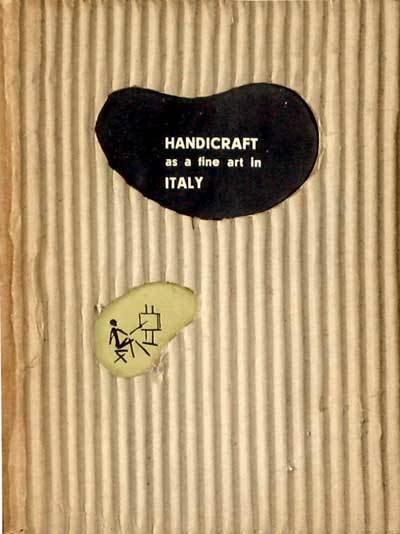"Carlo Ludovico Ragghianti, CADMA’s chairman, described the exhibition’s aim as ‘to perfect the quality of the Italian handicrafts by means of collaboration between artists and craftsmen’. Ragghianti described this ‘experiment’ as ‘part of a wider plan of action devoted to the revival and development of Italian handicrafts and [.] to the harmonising of Italian handicraft production with foreign and especially American, requirements’. Exhibits included ceramics, furniture, silverware and textiles designed by artists including Renato Guttuso, Fontana, Melotti, Giorgio Morandi and an abstract sculpture by the architect Sottsass. The catalogue, designed by the artist and designer Bruno Munari, reveals the unevenness of this collaboration – or at least its representation. Although no paintings were included in the exhibition, the cut-out corrugated cardboard cover depicts the creative work of the artist rather than artisan: a painter at his easel rather than a potter at his wheel. This is continued inside: the names and profiles for the thirty six artists and one architect are included but no details of the makers themselves are given – these are Sabatino’s anonymous ‘ghosts of the profession’ mentioned in the introduction. "Handicrafts as a Fine Art in Italy" was arguably one of the first exhibitions to present craft as art in post-war America. It precedes the larger MoMA exhibition XX Century Italian Art from 1949, which included terracotta and ceramic works by Arturo Martini and Fontana and which Lisa Hockemeyer has argued ‘demonstrates the curators’ acceptance of ceramic as a sculptural medium’. Both exhibitions in fact predate the widespread acceptance of the use of clay for artistic expression in the American context – as seen in the New York art world’s resistance to the Abstract Expressionist ceramics of Peter Voulkos and his Californian cohorts. It illustrates the difference of the concept of craft and art in the Italian context: for Hockemeyer, these artists’ use of clay was a result of the breakdown of hierarchies between the fine and decorative arts that occurred in the 1930s. It also speaks of the embryonic status of the field of design, in which there was an openness to who the modernisers of Italy’s crafts would be - artists or architects." A cura di Bruno Munari, una introduzione di Carlo Ludovico Ragghianti e le presenze di Afro, Mirko, Enrico Bordoni, Broggini, Campigli, Pietro Cascella, Casorati, Cherchi, Clerici, Consagra, De Pisis, Fabbri, Fontana, Fornasetti, Renato Gregorini, Guerrini, Guttuso, Levi, Paola Levi Montalcini, Marino, Melotti, Giovanni Michelucci, Morandi, Adriana Pincherle, Anita Pittoni, Pizzinato, Emanuele Rambaldi, Santomaso, Sassu, Carlo Sbisà, Maria Signorelli, Ettore Sottsas jr., Enrico Steiner, Nino Ernesto Strada, Turcato, Gianni Vagnetti. La mostra è presentata dalla CADMO, creata a Firenze dall’italo-americano Mar Ascoli, come organizzazione italiana della Fondazione americana "Handicraft Development Inc." con sede nella Casa dell’Artigianato Italiano dovuta all’architetto triestino Gustavo Pulitzer Finali. Stampato a Milano da Piero Bortolotti — Testi: Munari Bruno, Ragghianti Carlo Lodovico. pagg. 80; BN; rileg. cartone corrugato. Editore: Handicraft Development, New York, 1948.

Find out how to use
Find out how to use
